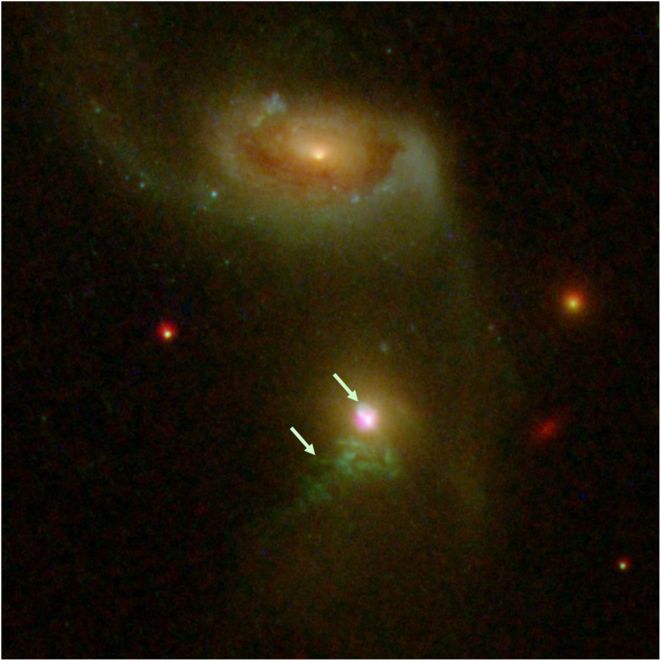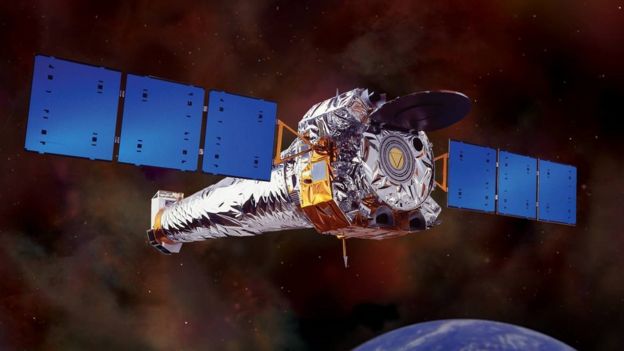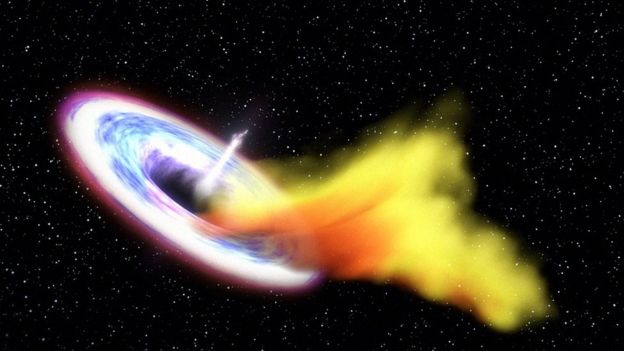Huge black hole blasts out 'double burp'
 NASA/STSCI/CXC
NASA/STSCI/CXC
Astronomers have caught a massive black hole letting out a "double burp" after bingeing on hot gas.
When cosmic gas comes near one of these sinkholes, it gets sucked in - but some of the energy is released back into space in the form of a burp.
Now, the Hubble and Chandra space telescopes have detected a new belch emerging from a black hole located about 800 million light-years away.
But they saw a remnant of another belch that occurred 100,000 years earlier.
"Black holes are voracious eaters, but it turns out they don't have very good table manners," Julie Comerford, from the University of Colorado, Boulder, told the 231st American Astronomical Society meeting in Washington DC.
"There are a lot of examples of black holes with single burps emanating out, but we discovered a galaxy with a supermassive black hole that has not one but two burps."
The burp itself consists of a stream of high-energy particles that is kicked back from the black hole.
Supermassive black holes are the largest type and are found at the centres of nearly all big galaxies. X-ray emission from the galaxy in question - called SDSS J1354+1327 - was picked up by the Chandra telescope, allowing researchers to pinpoint the location of its central black hole.
 NASA
NASA
Hubble was able to show them that a cloud of blue-green gas extending away from the black hole represented the aftermath of an earlier burp. They found that electrons had been stripped from atoms in the cone of gas and surmise that this was caused by a burst of radiation from the vicinity of the black hole.
In the meantime, it had expanded 30,000 light-years away from the black hole itself.
But the astronomers found a little loop in the images; the sign of a new belch emerging from the cosmic sinkhole.
"This new burp is actually moving like a shockwave that is coming out very fast," said Dr Comerford.
"I thought of an analogy for this and I was debating whether to use it or whether it's a little too gross... imagine someone eating dinner at their kitchen table and they're eating and burping, eating and burping.
 NASA
NASA
"You walk in the room and you notice there's an old burp still hanging in the air from the appetiser course. Meanwhile, they're eating the main course and they let out a new burp that's rocking the kitchen table."
She said the black hole was going through a cycle of feasting, burping and napping, before starting over.
The observations are important because they support previous theories - not demonstrated until now - that black holes should go through these cycles. The black holes were expected to become very bright in the process of feasting and burping and then go dark during the nap phase.
"Theory predicted that black holes should flicker on and off very quickly and this galaxy's evidence of black holes does flicker on timescales of 100,000 years - which is long in human timescales, but in cosmological timescales is very fast," said Julie Comerford.
The researchers think the black hole erupted twice because it consumed two separate meals. The reason for this might lie with the fact that the galaxy it's in had collided with another galaxy nearby. This would provide plenty of cosmic gas on which a black hole could feast.
"There's a stream of stars and gas connecting these two galaxies. That collision led gas to stream towards the supermassive black hole and feed it two separate meals that led to these two separate burps," said the University of Colorado researcher.
The results are published in the Astrophysical Journal.
No comments:
Post a Comment
Note: Only a member of this blog may post a comment.